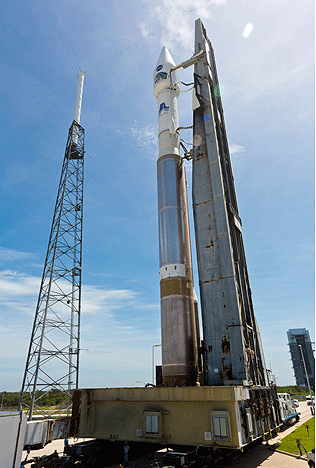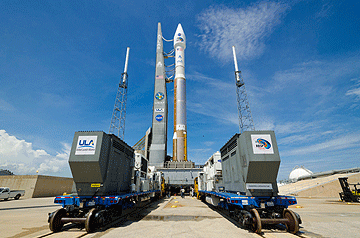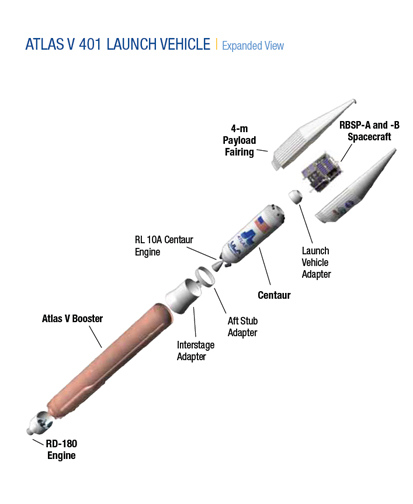
Cape Canaveral Air Force Station, Fla. (Aug. 28, 2012) - A United Launch Alliance Atlas V stands ready for launch at Space Launch Complex-41 with NASA’s twin Radiation Belt Storm Probes (RBSP) payload. Launch is set for Thursday, Aug. 30 at 4:05 a.m. EDT. RBSP will study changes in Earth's space environment caused by the sun that can disable satellites, create power grid failures and disrupt GPS service. Photo by Pat Corkery, United Launch Alliance
[SatNews] A new launch window is available (and new photos), and so once again the launch is set for...
Everything is progressing well in preparation for NASA’s Atlas V RBSP launch set for Thursday, August 30 from Space Launch Complex 41 at Cape Canaveral Air Force Station in Florida. The launch window opens at 4:05 a.m. EDT and extends for 20 minutes. Today’s L-3 forecast shows a 60 percent chance of favorable weather conditions for launch.
Weather Forecast
Overall probability of violating weather constraints: 40 percent
Primary concern(s): Thick Cloud
Overall probability of violating weather constraints for 24 hour delay: 30 percent
Primary concern(s): Thick Cloud
The ULA team is proud to be the launch provider for the Radiation Belt Storm Probes mission. The two RBSP spacecraft will be launched into orbit around the Earth, sampling the harsh radiation belt environment where major space weather activity occurs.
The mission, part of NASA’s Living With a Star Program, will provide unprecedented insight into the physical dynamics of the radiation belts and provide scientists data to predict change in this critical region of space. The ULA team is focused on attaining Perfect Product Delivery for the RBSP mission, which includes a relentless focus on mission success (the perfect product) and also excellence and continuous impro Primary concern(s): Cumulus Cloud
RBSP Spacecraft | Overview
The twin RBSP spacecraft are built and operated by the Applied Physics Laboratory (APL) of Johns Hopkins University (JHU). Weighing in at approximately 1,450 lbs each, the spacecraft will make dual measurements in the Earth’s radiation belts to observe changes through both space and time.

The RBSP spacecraft have nearly identical elliptical orbits and will operate within the radiation belts throughout their 2-year primary mission. The orbits cover the entire radiation belt region and the spacecraft will lap each other several times over the course of the mission. The RBSP in situ measurements will discriminate between spatial and temporal effects, and compare the effects of various proposed mechanisms for charged particle acceleration and loss. Each RBSP spacecraft carries a number of instruments in support of the mission’s science objectives:

- Energetic particle, Composition, and Thermal Plasma Suite (ECT) will directly measure near-Earth space radiation particles to understand the physical processes that control the acceleration, global distribution and variability of radiation belt electrons and ions.
- Electric and Magnetic Field Instrument Suite and Integrated Science (EMFISIS) will focus on the role played by magnetic fields and plasma waves in the processes of radiation belt particle acceleration and loss.
- Electric Field and Waves Suite (EFW) will study the electric fields in near-Earth space that energize radiation particles and modify the structure of the inner magnetosphere.
- RBSP Ion Composition Experiment (RBSPICE) will study how space weather creates the “storm-time ring current” around Earth and determine how that ring current supplies and supports the creation of radiation populations.
- Relativistic Proton Spectrometer (RPS) will measure inner Van Allen Belt protons with energies from 50 MeV to 2 GeV.

